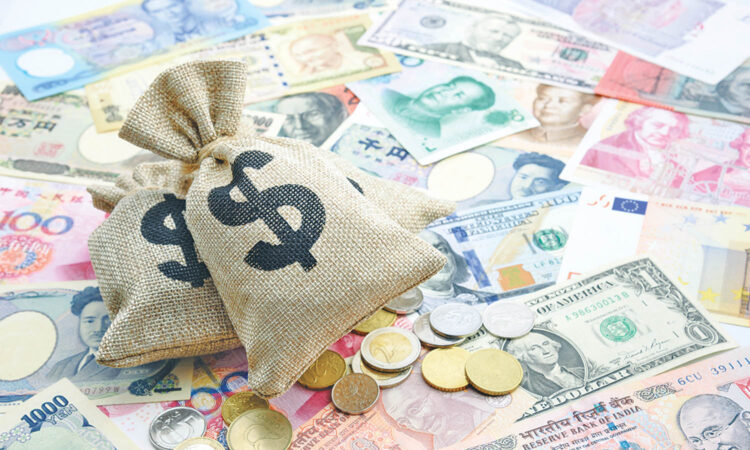
The Nepali rupee plunged to an all-time low of Rs133.54 against the dollar on September 20 and it is currently trading at Rs133, the buying rate for customers. A strong US dollar has several advantages and disadvantages. It benefits some but negatively impacts others.
Here is what you need to know about the appreciation of the US dollar against the Nepali rupee.
What does a strong US dollar mean for Nepal’s economy?
Again, there are both positive and negative sides to the strong US dollar and its impact on Nepal’s economy. According to Nara Bahadur Thapa, former executive director of Nepal Rastra Bank, the depreciation of the domestic currency could exert pressure on the balance of payments.
“This triggers inflation as the country is highly dependent on imported goods and has a very low level of domestic production,” said Thapa. The maximum impact will be on purchasing petroleum products, which Nepal imports entirely. It will also impact the cost of chemical fertilisers.
The appreciation of the US dollar, on the other hand, can benefit remittance earners. A strengthening dollar means tourists can buy more of the Nepali currency. Visitors from abroad will find the prices of goods and services in Nepal cheaper.
With the Nepali rupee sinking against the US dollar, the government has to dish out more in the domestic currency to repay external debts as the exchange rate works against it. When the country was hit by deadly earthquakes in 2015, Nepal’s debt—both external and internal—surged as the country had to spend huge amounts of resources on the reconstruction of damaged infrastructure.
Why is the dollar rising?
The Federal Reserve, the central bank of the United States, is increasing the interest rates to cool down the inflation rate to its 2 percent target. The interest rate in the US is now 5.5 percent, up from 2.5 percent a year ago. The US inflation rate is currently at 3.67 percent compared to 3.18 percent last month and 8.26 percent last year. American consumers benefit from the highly valued dollar as it reduces inflation, enabling the purchase of imported goods at lower prices.
Economists say that the central bank’s interest rate does have an impact on inflation. An increase in the policy rate by 1 percentage point results in a decrease in the inflation rate by 0.5 percentage points. Rising interest rates help reduce the overall demand and perhaps ease the upward pressure on prices. In the US, higher interest rates are generally a policy response to rising inflation. By increasing borrowing costs, rising interest rates discourage consumer and business spending. There are other factors that increase the dollar’s rate.
According to Thapa, American institutional investors park their investments globally and look for returns. When the US interest rate is high, they get returns. The US has its portfolio investments in Thailand, Singapore, India, and Japan, among other countries. There is around $40 billion portfolio of American investment in India, said Thapa.
When does the appreciation of US dollar impact Nepal?
The appreciation of the US dollar hits the Nepali consumer, particularly during the festive times. Nepal’s inflation soars, especially ahead of the festivals if there’s a rise in the dollar, as everything is imported, said Thapa. The first impact of a strong US dollar is on the price of petroleum products, as Nepal’s annual imports are valued at around Rs300 billion. The price of petrol, which was Rs178 per litre a month ago, reached Rs183 a litre this week. As the dollar becomes more expensive, petroleum products will get costlier. The cost of production will increase, and so will the price of imported goods.
How strong will the US dollar be?
It takes around 2 to 3 months for the US inflation to cool, said Thapa. “Until the inflation comes down, the Federal Reserve will increase the interest rate again.” India will also try to intervene in the market by selling some of its foreign currency. As the Nepali currency is pegged to the Indian currency, the response of India will be crucial for Nepal too.
As the Nepali rupee is pegged to the Indian currency, Nepal imports India’s inflation. But why is the Indian currency slipping too?
The US portfolio investment in India, especially in shares and bonds, worth tens of billions is apart from the foreign direct investment. Even a fluctuation of $5 billion or $10 billion impacts the exchange rate, which eventually hits the US dollar as well. The fluctuation in the Indian currency and the US dollar in India immediately impacts the Nepali currency, said Thapa.
Nepali currency becomes strong automatically when the Indian currency is strong and weakens when the Indian currency weakens. Nepal has been following a pegged exchange rate system with the Indian rupee.
Nepal adopts a different kind of exchange rate system for other convertible currencies.
In line with the economic liberalisation policy followed since the mid-1980s, Nepal introduced current account convertibility in 1993, effectively pegging the Nepali rupee to the Indian rupee at the rate of 1.60, the same rate fixed in 1960 when the two currencies were pegged first. Since 1993, the exchange rate of the Nepali rupee with other convertible currencies has been market-determined in line with the exchange rate of the Indian rupee with convertible currencies.



